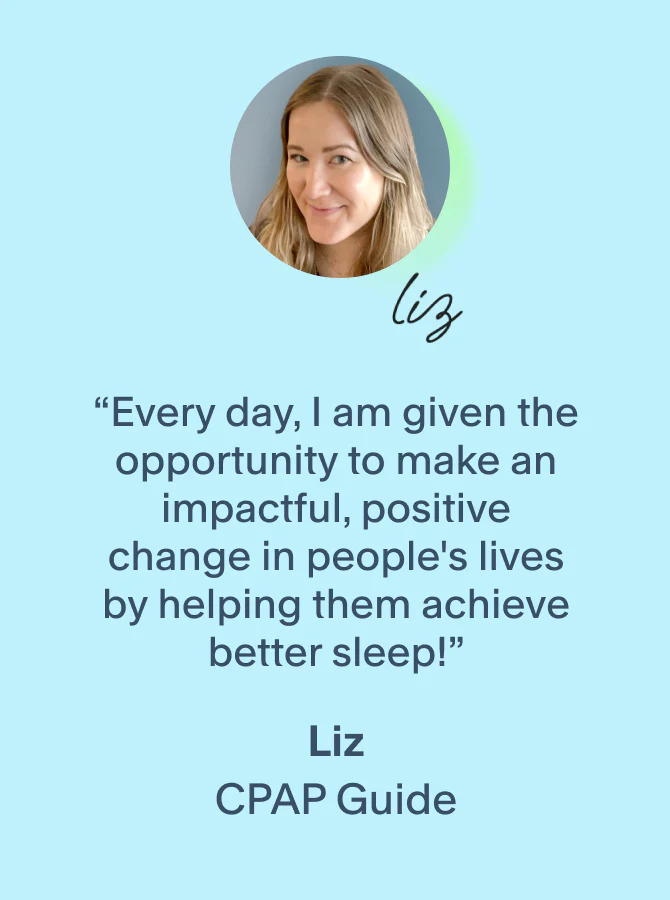Our content undergoes rigorous expert review, evidence-based research, and regular updates for accuracy.
There are dozens of reasons why you may find yourself struggling to wake up feeling well-rested each morning, but with nearly one in seven people affected worldwide, Obstructive Sleep Apnea (OSA) is undoubtedly one of the most common. And if you've found this article, you may have some concerns that you or a loved one may be one of them. If so, we’re here to provide you with trustworthy information to help you better understand this condition.
So, what is obstructive sleep apnea? OSA is a disorder that is characterized by repeated episodes of a partial or complete collapse of the upper airway during sleep. This blockage leads to decreased airflow or even brief pauses in breathing throughout the night. As a result, the individual experiences disrupted sleep, loud snoring, and other potential health risks.
In this comprehensive guide, we will take a deeper look into the cause, symptoms, and treatment of OSA. We’ll explore how sleep apnea can affect your health long-term, plus discuss its risk factors and prevention. Finally, we will cover how this condition affects daily life and address some common concerns regarding OSA.
Cause of Obstructive Sleep Apnea
As we mentioned previously, OSA occurs when the airway becomes blocked, which ultimately affects your ability to breathe correctly as you sleep. This obstruction occurs due to a combination of two processes that affect the muscles of the throat.
First, when you go to sleep at night, your muscles are designed to relax so that they can recover and repair after the events of each day. While this process is normally a good thing, sometimes they can relax too much. This can be a problem if the airway is already naturally narrow for one reason or another.
These effects are enhanced even further if those muscles become overworked or tired by the end of the day. In the case of obstructive sleep apnea, it’s the muscles in the neck and throat that become fatigued. Oftentimes this is due to underlying issues that have either weakened those muscles or caused them to experience additional strain throughout the day, such as aging or being surrounded up fatty tissue.
Symptoms of Obstructive Sleep Apnea
When you have OSA, breathing at night becomes more difficult as it is harder to bring air past the obstructed pathway and into the lungs. In the case of partial blockage, this added resistance changes the way that each breath of air moves through the airway during inhalation. This is what causes the loud snoring sound that is associated with this condition.
However, there can also be periods during which the airway becomes fully blocked. When this happens, the brain quickly senses that it is not getting the oxygen that it needs and wakes you up. This change in alertness startles your muscles out of that state of relaxation. The airway then responds by opening up once again, allowing you to take in that much-needed breath of fresh air.
People living with OSA are likely to experience some or all of the following:
- Loud and chronic snoring
- Short episodes of breathing pauses
- Waking with the sensation of choking or gasping for air
- Excessive daytime sleepiness
- Difficulty staying asleep
- Dry mouth
- Sore throat
- Morning headache
- Struggling to feel rested upon waking
- Cognitive changes
- Mood changes
Stages of Obstructive Sleep Apnea
Experts categorize each case into one of three stages. These range from mild to severe obstructive sleep apnea. Generally speaking, most of the symptoms of severe sleep apnea can also be symptoms of mild sleep apnea. That said, in severe cases, these issues tend to arise more often and are much more impactful in day-to-day life.
When a person is first diagnosed with OSA, doctors will determine the stage of their case using either the Apnea-Hypopnea Index (AHI) or the Respiratory Event Index (REI). Both systems are based on the number of times that your oxygen levels are impacted for more than ten seconds during sleep. Doctors identify this number by having you complete a sleep study, which can identify moments in which your airway becomes partially (hypopnea) or totally blocked (apnea).
The stages of obstructive sleep apnea are:
- Mild: 5-14 AHI/REI
- Moderate: 15-29 AHI/REI
- Severe: 30 or more AHI/REI
Treating Obstructive Sleep Apnea
If you are diagnosed with this form of sleep apnea, your doctor may suggest making some lifestyle changes that can reduce the severity of your condition or reverse the effects altogether. Your provider will likely want you to pair these changes with sleeping with some type of Positive Airway Pressure (PAP) device.
These machines work by directing pressurized air through the airway and into the lungs. While this flow of air helps to deliver air directly into the lungs, its primary purpose in OSA is to keep the airway open. There are several different types of PAP devices, but doctors typically prescribe one of the following.
- Continuous Positive Airway Pressure: CPAP machines deliver a constant flow of pressurized air into the airway. The correct level of air pressure needed is determined by a sleep specialist or respiratory tech. If changes need to be made to the pressure setting, it must be done manually. These devices are usually the preferred first line of treatment for people with OSA.
- Automatic Positive Airway Pressure: Like CPAP, an APAP device continuously pushes pressurized air into the lungs. However, the amount of pressure is not set to just one level. Instead, this machine automatically senses changes in the person’s breathing patterns and makes pressure changes as needed throughout the night. APAPs tend to be prescribed for people who have a lot of variability in the severity of their OSA, such as people who are prone to allergies and may experience worse apnea during flare-ups.
- Bi-Level Positive Airway Pressure: BiPAPs use one of two different pressure settings during the phases of each individual breath cycle. During inhalation, a BiPAP machine will deliver highly pressurized air, but during exhalation, that air pressure is reduced. The purpose of this is to make it easier to exhale while using the device. It is most commonly suggested for people who have either severe OSA or other conditions which impact their ability to breathe regularly.
Health Impacts of Obstructive Sleep Apnea
Studies show that OSA can have far-reaching impacts on your health and wellness. Some of these are undoubtedly related to poor sleep. But others are actually believed to be the result of damage that is caused when the body and brain go without oxygen, even for short bursts of time.
Sleep apnea has been linked to a diminished amount of antioxidants in the body. This is concerning because these compounds play a key role in fighting off the damaging effects of free radicals, which cause things like inflammation, cancer, and even aging.
If you believe you may have OSA, it’s important to contact your doctor so that your concerns can be addressed before you begin to experience any sleep apnea complications.
Effects of Untreated OSA
Obstructive sleep apnea can have several long-lasting effects, particularly if it goes unaddressed for years. It can increase your risks for chronic health conditions, reduce your quality of life, and even shorten life expectancy.
Below are some of the dangers of sleep apnea:
- High Blood Pressure: OSA has been proven to cause [constriction of the blood vessels](https://pubmed.ncbi.nlm.nih.gov/11779731/#:~:text=Our data suggest that obstructive,may be linked to hypoxia.), particularly in the limbs. This causes the blood vessels to become smaller, which ultimately leads to an increase in blood pressure.
- Heart Disease: When the body goes without oxygen, even temporarily, it causes the heart to pump harder. Ultimately this leads to additional stress on the heart that, over time, results in heart disease.
- Stroke: The effects of sleep apnea are known to cause damage to the blood vessels in the brain. This leaves you with an increased risk for stroke.
- Diabetes: Studies show that OSA causes your body to become less [sensitive to insulin](https://www.e-dmj.org/journal/view.php?number=611#:~:text=OSA induced intermittent hypoxia and,that eventually lead to diabetes.), which increases your risk of developing type 2 diabetes.
- Depression: A good night’s rest is vital for mental health. So when sleep apnea causes multiple arousals from the deep sleep stage, it can start to take a toll on your mind, including causing depression.
- Sexual Dysfunction: If it goes on for long enough, poor sleep can eventually lead to hormonal changes, including testosterone and estrogen. As a result, sexual function can be significantly impacted in both men and women.
- Obesity: Sleep apnea can cause your metabolism to slow and impact hormones related to the digestive process. In such cases, you may find yourself continuing to gain weight, despite lifestyle changes.
Risk Factors of Obstructive Sleep Apnea
There are several factors that have been known to increase your likelihood of developing sleep apnea. Some are linked to lifestyle choices that can be addressed, but there are others that are harder to avoid.
Here are some risk factors for OSA:
- Being Overweight: Being overweight is associated with having excess body fat, which often collects in the neck. Ultimately this can reduce the activity of the muscles in that area, which [increases the risk](https://www.ncbi.nlm.nih.gov/pmc/articles/PMC5836788/#:~:text=In obese people%2C fat deposits,ultimately resulting in sleep apnea.) of airway obstruction.
- Being Male: Based on clinician data, men are much more likely to develop OSA compared to women. Additionally, they are also more likely to experience more severe cases. This may be due to the fact that men tend to have more neck fat compared to women.
- Being 40 Years Old: Although OSA can occur at any age, it's more common in people who are over 40. This is likely because the muscles in our bodies tend to weaken over time.
- Having a Large Neck: According to the Mayo Clinic, women who have a neck size of more than 16 inches and men whose necks measure more than 17 inches are more likely to have OSA.
- Taking Sedatives: Some sedatives can trigger muscle relaxation, which may lead to the muscles in the airway becoming over-relaxed to the point that they begin to block the airway.
- Having Structural Abnormalities: Certain structural abnormalities, such as a narrow airway, large tonsils, or a big tongue, may cause your airway to become obstructed much more easily compared to other people.
- Drinking Alcohol: Alcohol consumption is believed to increase your risk of developing OSA, as well as increase the dangers of sleep apnea in existing cases. People who have OSA and drink alcohol are likely to have lower oxygen levels during each episode of apnea and hypopnea.
- Smoking: Individuals who smoke have an increased risk of damage to their airways and lungs. This can lead to inflammation, which can significantly worsen sleep apnea.
- Undergoing Menopause: The hormonal changes that occur during menopause can worsen symptoms of obstructive sleep apnea and may even trigger it.
- Having Family Members with OSA: Research suggests that you can be genetically predisposed to having OSA. Additionally, you can inherit other traits that happen to already be risk factors for sleep apnea, such as having unusually large tonsils or being more likely to struggle with your weight.
- Experiencing Nasal Congestion: People who experience nasal congestion may be at a greater risk of developing mild sleep apnea. Researchers believe this may be due to the fact that the muscles along the airway change how they function when people are forced to breathe through their mouths rather than their noses.
Preventing Obstructive Sleep Apnea
As mentioned above, many of the risk factors for this type of sleep apnea are linked to certain lifestyle habits. Here are some ways that you can reduce your risk of developing this condition!
- Maintain a healthy weight.
- Get regular exercise.
- Avoid and/or quit smoking.
- Limit the amount of alcohol you drink.
- Treat underlying medical conditions that affect your breathing at night.
- Sleep on your side to make it easier for your airway to stay open.
Living With Obstructive Sleep Apnea
If it goes undiagnosed for too long, OSA can have a profound effect on your daily life. It’s important to know the day-to-day warning signs of sleep apnea, especially if you don’t have anyone to alert you to your snoring. So, what does sleep apnea feel like?
According to one woman’s firsthand account, undiagnosed OSA left her feeling as though her entire life “revolved around tiredness.” It led her to seek dozens of treatments from numerous experts. The side effects even prompted doctors to initially diagnose her with severe depression. After years of struggling, she learned about sleep apnea, which led her to seek a sleep study. Thankfully things turned around after coming to the realization that she had obstructive sleep apnea.
With sleep apnea, you will likely feel as though you can never get a full night of rest. Even in mild cases, sleep apnea can disturb deep sleep dozens of times a night. In the worst cases, it can be hundreds. This can leave you feeling perpetually exhausted and may even have an effect on your brain function.
According to some people with this form of sleep apnea, these changes can eventually begin to impact daily life to the point that they can have an effect on relationships with friends and family. The loud snoring can complicate things further by making it difficult to share your bed with a partner. Also, the moments when you stop breathing can be a terrifying experience for both yourself and the other person. This can often trigger feelings of anxiety and may cause others to become concerned for your health.
Everyday Effects of Living With OSA
The effects of excessive sleep disturbances can linger well after you wake up in the morning. If your day often involves a combination of some of the following signs, you may have sleep apnea.
- Excessive daytime sleepiness or fatigue
- Trouble concentrating
- Difficulty remembering things
- Decreased work performance
- Mood swings or irritability
- Accidents due to drowsiness
Common Concerns of People Living With OSA
If you are new to the sleep apnea journey, you may have already had a few worrisome experiences when it comes to breathing troubles. Here are some of the more concerning experiences that may occur when you have this form of OSA.
Waking Up While Gasping for Air
If you have ever woken up feeling as though you were holding your breath before finally letting out a sudden gasp, you have likely found yourself wondering, “Why do I puff out air when I sleep?”
This is actually a pretty common experience for people with obstructive sleep apnea. It occurs because it is a response to your brain sending signals to your body to wake up because it senses that it is low on oxygen due to airway blockage. If this is a common experience for you, we encourage you to speak with your healthcare provider!
Sleep Choking Syndrome
We get it, reading up on sleep apnea can be a bit stressful. And the condition itself can involve some pretty scary-sounding things. One of the best examples is sleep-choking syndrome, which is often mentioned in relation to OSA. But what is sleep-choking syndrome?
Also known as sleep-related laryngospasm, this syndrome is characterized by sudden, involuntary spasms in the laryngeal muscles, which occur while you are asleep. These can cause you to suddenly wake up while you are choking or gasping for air. While sleep-choking syndrome can occur in people without sleep apnea, having OSA does increase your risk for it. Again, if you have any concerns about this or any other sleep-related breathing issues, it’s best to see your doctor!
Frequently Asked Questions
What Is the Main Cause of Obstructive Sleep Apnea?
OSA is mainly caused by a narrowing of the airway. This can sometimes occur due to preexisting structure issues in the airway, but usually, it is caused when the muscles in the throat collapse, resulting in a partial or total blockage of the airway. This condition is more common in people who are obese, male, and over the age of 40.
How Serious Is Obstructive Sleep Apnea?
There can be many dangers associated with untreated sleep apnea. The oxygen shortage that is created when the airway is blocked can have long-lasting effects on your body. OSA has been linked to heart disease, high blood pressure, diabetes, and more.
Can Sleep Apnea Be Cured?
Obstructive sleep apnea can be reversed, but it often requires changing your habits. If you have OSA, your doctor will likely suggest making changes to your diet, exercising regularly, and maintaining a healthy weight.
Who Suffers From Sleep Apnea?
OSA affects people of all ages, genders, and ethnicities. That said, there are some traits that definitely increase your likelihood of developing this form of sleep apnea. These include being over the age of 40, being a man, and being overweight.
How Do You Fix Sleep Apnea Naturally?
Currently, there are few natural treatments for sleep apnea. However, there is a form of treatment called dental appliance therapy, which does not require a mask and is not attached to a machine. This device changes the position of your jaw, which keeps your airway from becoming easily blocked. Additionally, sleeping on your side may help decrease the severity of your sleep apnea.
Of course, the best way to naturally fix your OSA includes making lifestyle changes, such as maintaining a healthy weight, quitting smoking, and limiting your alcohol intake.
Can You Recover From Obstructive Sleep Apnea?
Yes! With proper treatment and lifestyle changes, many people can effectively manage and even recover from OSA. The key is to address it early on before your symptoms become severe. Untreated sleep apnea can lead to long-lasting issues such as inflammation and chronic illness, which may be difficult to resolve.
How Can I Test Myself for Sleep Apnea?
The first step in getting tested for sleep apnea is to speak with your doctor regarding your concerns. If they share your concerns, your provider will then help you determine the best testing method for you.
In some cases, they may suggest an at-home sleep apnea test. This test allows you to rest in the comfort of your own home while you wear a device that records your oxygen levels as you sleep. Your results are then sent to a specialist who will then determine if you have OSA.
Final Thoughts
Obstructive sleep apnea is a sleep-breathing disorder that can make it difficult for you to get the oxygen you need due to airway blockages. It is often characterized by its two hallmark symptoms— waking up gasping for air and loud snoring. Common risk factors include being male, over the age of 40, and overweight.
If you have concerns regarding sleep apnea, it is incredibly important that you inform your doctor. This is because undiagnosed OSA can have long-lasting effects, including heart disease and diabetes. Should you find yourself newly diagnosed with OSA, your doctor may suggest a CPAP machine or other Positive Airway Pressure device, which can help to keep your airway open as you sleep. Additionally, they will likely encourage you to make some lifestyle changes to reduce your risks for sleep apnea.
When it comes to sleep apnea, we believe that knowledge is power, and understanding OSA can help you take control of your sleep health. Don't hesitate to share this information with friends and family members who may also be affected by sleep apnea. Together, we can work towards better sleep and healthier lives!








